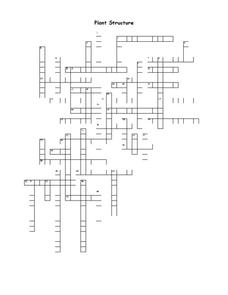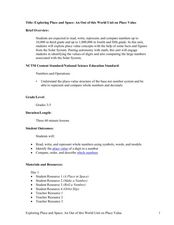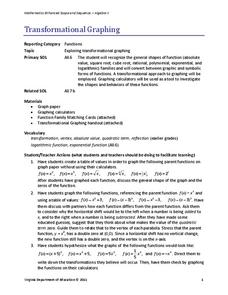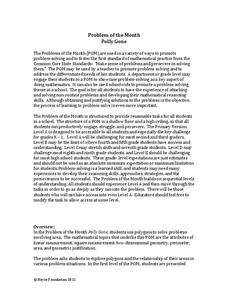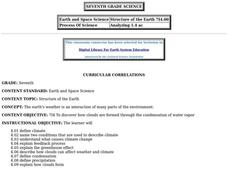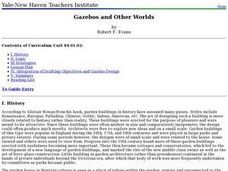Curated OER
Isometric Drawings 2
In this isometric drawings worksheet, students analyze the drawing of the structure that can be made with cube blocks. Students use cube blocks to make the structure and then draw three different views on the dotted grid.
Curated OER
Junior Architects of America
Students create entries for the Architects of America contest, including a model of a futuristic structure, blueprints, a list of all plane and solid shapes in the structure, a persuasive argument paper that describes why the structure...
Curated OER
Plant Structure
In this plant science worksheet, students complete a crossword puzzle with 48 questions. They identify the different parts of a plant.
Curated OER
Various Volumes
For this volume worksheet, students create different sized cubes and compare the sizes by pouring sand from one cube into another. Students follow 4 directions and reflect on their findings.
Illustrative Mathematics
1.OA, NBT, The Very Hungry Caterpillar
First graders are exposed to addition of three whole numbers in a math activity centered around Eric Carle's, The Very Hungry Caterpillar. As the teacher reads, young mathematicians use counters and ten-frames to symbolize the number of...
Curated OER
Exploring Place and Space
Students explore number values by completing mathematical worksheets in class. In this decimals lesson, students identify the different place values a number has and the use of decimals to represent a fraction of a number. Students...
Teach Engineering
Seeing All Sides: Orthographic Drawing
How can your draw three-dimensional figures on paper? The lesson shows pupils how to draw orthographic projections of three-dimensional figures composed of cubes. After viewing a PowerPoint presentation, they practice this skill with...
Teach Engineering
Let's Take a Spin: One-Axis Rotation
Investigate the effect of one-axis rotations on geometric figures. Scholars learn to use snap cubes and the right-hand rule to draw figures after rotations about the x-, y-, or z-axes. They try their hands at examples created by the...
Curated OER
Interesting Integers and Exciting Equations
An 80-page resource provides four lessons and all associated worksheets to teach middle schoolers about expressions and equations. The lessons are hands-on, using games, "integer chips," a balance and cubes, and cut and paste activities....
Virginia Department of Education
Transformational Graphing
Find relationships between the structure of a function and its graph. An engaging lesson explores seven parent functions and their graphs. Learners match functions to their graphs and describe transformations.
Noyce Foundation
Poly-Gone
Investigate polygons from rectangles to triangles to octagons. Each level of the five-problem series targets a different grade level. Beginning with the level A problem, learners examine the relationship between area and perimeter by...
Curated OER
TE Activity: The Boxes Go Mobile
Students create a mobile of boxes and cubes that they made in a previous lesson that can be accessed from this page. They design the mobile using method that an engineer would use to balance the items based on surface areas and volumes.
Curated OER
Structures
Students choose which building material to use to create their structure and which animal to house. After being read a story, they examine and identify the differnet types of homes mentioned. They take pictures of their structures...
PBS
Blue Ribbon Readers: Questioning
Model for your class how to become a better reader through questioning. After conducting a picture walk that introduces prediction strategies, learners play an interactive questioning cube game. Complete directions for the game and...
American Chemical Society
Atoms Can Be Rearranged to Make Different Molecules
Uncover the building blocks of the universe as budding chemists explore atoms and molecules in an exciting inquiry-based activity. Investigators view an interactive video describing the chemical structure of six molecules. Using...
Curated OER
Investigation Can You Build This?
Students work in small groups to explore spatial relationships while building with color cubes. Students must identify positions of blocks to partner, recreate a model, and color a sketch of their structure appropriately.
Curated OER
Pop-it...Stop-it
Students observe how certain geometric shapes can be used to make some structures rigid and others flexible. The activity involves construction of a 30-60 right triangle, folding while following directions, and identifying polygons.
Curated OER
Understanding 10: Backwards and Forwards
Help your young mathematicians completely master 10 by practicing one-to-one correspondence, number recognition, and recording numbers displayed. They make 10 with groups of two-different colored cubes and color in 10-frames to show how...
Curated OER
Structure of the Earth
Seventh graders study the cause of climate change, and how clouds form and affect weather. They define condensation and precipitation, the greenhouse effect and the water cycle.
Mathematics Assessment Project
Representing Functions of Everyday Situations
Functions help make the world make more sense. Individuals model real-world situations with functions. They match a variety of contexts to different function types to finish a helpful resource.
Curated OER
Gazebos and Other Worlds
Design a simple structure such as the gazebo. Work with your class to identify the six faces of a cube pattern and name other uses of patterns in industry. They draft, cut out, and assemble a cube pattern. They draw out and assemble two...
Curated OER
The Living Earth-Glaciers
Young scholars investigate glaciers. In this earth science lesson, students use sandy ice cubes to observe how glaciers change the land. Young scholars list forces that cause changes in the Earth's surface.
Curated OER
Building Buildings
Seventh graders investigate 2-D and 3-D objects. In this geometry instructional activity, 7th graders begin to understand spatial reasoning. Students look at pictures of the NYC Skyline and discuss what it looks like from different...
Curated OER
Sim's Cities
Young scholars investigate city management and government by creating a fictional city in groups. In this civics instructional activity, students create rules and a mascot for their fictitious city which they create from poster board...




